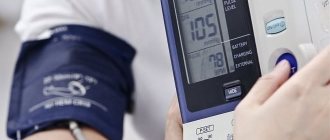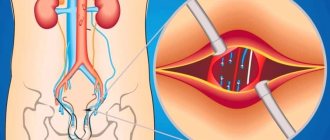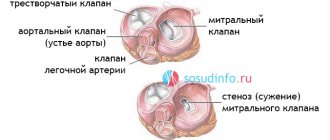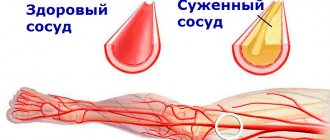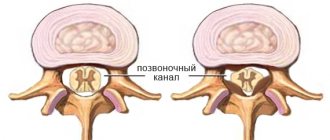When may stenting be needed?
There are several pathological conditions in which this intervention significantly improves the quality and life expectancy, and sometimes even saves. These are the diseases:
- stable angina;
- silent myocardial ischemia;
- acute coronary syndrome with and without ST segment elevation.
All of these are forms of coronary heart disease, which occurs due to partial or complete blockage of the lumen of the arteries that supply the heart muscle. The cause of such blockage is most often atherosclerosis.
Progress of percutaneous coronary intervention:
1. The site of exposure is treated with an antiseptic. The patient is given a local anesthetic and blood thinning medications to prevent the formation of blood clots. Small electrodes are attached to the chest to help the surgeon monitor the heart rhythm and pulse rate. 2. The operation is performed through the femoral artery (on the leg) or the radial artery (on the arm). Through a small puncture, a catheter-port for carrying instruments (introducer) is installed. Through it, a catheter is delivered to the mouth of the coronary artery, with the help of which surgical intervention is performed. 3. Angioplasty of the coronary arteries with stenting is performed in an angiographic operating room equipped with high-tech medical equipment. Contrast liquid is injected through the installed catheter. Using a coronary angiogram, the doctor evaluates the affected area. 4. A balloon catheter is passed to the site of the lesion, expanding the narrowed area. As the balloon inflates, the patient may feel discomfort in the chest. This is due to the blocking of blood flow through the artery - after the balloon is deflated, the unpleasant sensation stops. Stent implantation: 1. The stent, mounted in a closed state on a balloon, is advanced to the narrowed area of the artery. 2. The surgeon inflates the balloon in the affected area, thereby expanding the stent. 3. The wire remains in the artery to keep it open and improve blood flow to the heart. 4. The surgeon removes the catheter and makes control coronary angiograms to assess the strength of blood flow through the dilated artery. 5. The doctor applies a pressure bandage to the area of the leg or arm where the catheter was inserted.
Coronary stenting takes from 30 minutes to several hours, depending on the severity of atherosclerosis. As prescribed by your doctor, after surgery you should take medications that minimize the possibility of blood clots. For a video of stenting of cardiac vessels, follow the link.
Operation description
The essence of this intervention is that a special device, a stent, is inserted into the narrowed artery. Cardiac stenting surgery is endovascular. Before the operation, the patient must undergo tests and have an ECG and an X-ray of the lungs. Operation stages:
- local anesthesia is administered to the groin area (the place where the instrument is inserted);
- a special catheter is inserted into the lumen of the femoral artery, which will be used for manipulation;
- the catheter is gradually passed along the aorta in the direction of the heart, a radiopaque substance is injected through it so that the surgeon can see the condition of the arteries and the location of the catheter on the screen of the X-ray machine;
- Having reached the heart, the doctor injects contrast into the coronary vessels and determines where exactly the narrowing is located;
- A stent is placed in the narrowed area, which is expanded by inflating the balloon located in it.
Rare complications:
- Myocardial infarction or heart attack.
- Coronary artery rupture or dissection. Damage requires coronary artery bypass grafting or emergency stent graft implantation.
- Impaired kidney function. The contrast agent administered during stenting and angioplasty has a detrimental effect on the kidneys. If the patient already has problems with their functioning, the doctor prescribes medications for protection.
- Stroke. During surgery, blood clots may form on the catheter. If they fragment, break off and travel to the brain, the patient will suffer a stroke. To reduce the risk of developing this complication, blood thinning medications are used.
- Arrhythmia. Manifested by heart rate disturbances: bradycardia or tachycardia. This is a temporary complication that goes away after the medication is administered. A temporary pacemaker is rarely required.
Complications during and after surgery
Any operation, even the most gentle one, is associated with a certain risk of complications. Stenting is no exception. Possible complications:
- heart attack or stroke due to plaque rupture caused by the catheter;
- atheroembolic syndrome (blockage of other vessels by the same plaque);
- hematoma at the site of catheter insertion;
- coronary artery perforation or dissection;
- stent thrombosis;
- bleeding or hematoma in the femoral area;
- allergic reaction to the injected contrast agent;
- renal dysfunction.
The risk of complications is extremely small and continues to decrease as the technique improves. Despite their presence, after stenting, the life expectancy of patients increases significantly, subject to constant monitoring by a cardiologist and taking appropriate medications.
Possible complications:
Coronary stenting rarely causes complications, but there are certain risks associated with it:
- Repeated narrowing of blood vessels (stent restenosis). If angioplasty is performed without stent implantation, the probability of restenosis reaches 30-40%. Installation of a bare metal stent reduces the possibility of relapse to 20%, and drug-coated stents - to 1%.
- The occurrence of blood clots. After some time, blood clots can form inside the stents, which are dangerous because they lead to a heart attack. To reduce the likelihood of their occurrence to a minimum, we recommend taking antiplatelet medications prescribed by your doctor: Plavix, aspirin, etc.
- Bleeding from the catheter site (arm or leg). In most cases, there will only be a slight bruise, but there is still a risk of serious bleeding.
Postoperative period and rehabilitation after stenting of cardiac vessels
Immediately after the end of the operation, the patient is transferred to an intensive observation unit, where he is connected to a cardiac monitor. It is monitored constantly - this is necessary in order to immediately recognize the development of complications: suddenly developed myocardial ischemia and arrhythmias. Blood pressure is also constantly monitored - its progressive decrease allows you to quickly detect internal bleeding that has begun.
The patient is usually discharged 3-4 days after surgery. In some cases, with an extremely low calculated risk of complications, the operated patient can be discharged even after a day, however, for this, the patient must be carefully examined before leaving the hospital.
In the early postoperative period, the only thing that is not recommended for the patient is increased physical activity. He can return to work immediately after discharge, however, several factors play a role here:
- what kind of work the patient does - mental or physical;
- how fully the surgeon’s goal of restoring blood flow was achieved;
- how strong are the residual effects of angina pectoris;
- what are the results of stress tests (does dosed physical activity provoke the development of angina attacks).
Modern methods of treating myocardial infarction and pre-infarction conditions can reduce the risk of severe course of these diseases. Life expectancy after stenting of cardiac vessels and in the absence of complications is almost the same as in healthy people. However, the Dobrobut.com website reminds that success will depend not only on the success of the operation, but also on the regularity of taking prescribed antithrombotic drugs and monitoring with a cardiologist. Do not ignore your doctor's instructions, and then the risk of re-narrowing of the arteries will be minimal.
Lifestyle after coronary artery stenting surgery
The article was published in the new issue of the journal of the Center for High Medical Technologies.
Read the entire issue
Stenting is a minimally invasive surgical intervention in which a stent is implanted into a patient’s coronary vessel narrowed by atherosclerotic plaques. A stent is a metal spiral made of cellular material, which expands in the lumen of the vessel, “presses” plaques into its wall and keeps its lumen free.
Installation of a stent leads to the fact that coronary blood circulation improves, the heart begins to receive more oxygen, and during physical activity the person does not experience myocardial ischemia. This eliminates angina attacks and improves a person’s well-being.
The apparent simplicity of stenting, the absence of the need for long recovery after it, as well as the noticeable therapeutic effect of the operation often create in patients the illusion of a complete recovery. However, stenting is aimed only at eliminating the symptoms of the disease. The cause of coronary heart disease - atherosclerosis - continues to exist and progress, creating a threat of recurrence of angina pectoris, the development of myocardial infarction, heart failure and other very serious problems. For this reason, a person who has undergone surgery must be fully aware of all the possible dangers of his situation and the need for further treatment.
After stenting
Unfortunately, the volume of drug therapy after stenting surgery will not decrease. The patient must understand that it is impossible to refuse medications for ischemic heart disease. After successful stenting of the coronary arteries, the drug therapy regimen is of great importance, in which dual antiplatelet therapy plays a decisive role (reducing the risk of stent thrombosis). Follow the treatment regimen and do not forget: your good health after surgery is largely maintained due to the fact that you follow the prescribed therapy regimen.
1) Physical activity is one of the most important lifestyle conditions after stenting. Regular exercise slows down the development of atherosclerosis, trains the heart muscle, helps stabilize blood pressure, and has a general health effect on the body. A patient who has undergone this operation should be prepared for the fact that from now on he must engage in physical activity at least 4-5 times a week. Among specific types of loads, special physical therapy exercises, walking, cycling, swimming, and jogging are recommended. Sports that require significant physical effort and potentially cause injury (weight lifting, boxing) are not recommended.
2) Nutrition after stenting
The second extremely important component of therapy is diet. It’s sad, but not all patients adhere to the recommended nutritional rules. And we can say without a doubt that this plays a big role in the high incidence of recurrent angina and repeated stenting. Diet therapy after stenting of coronary vessels should be based on the following principles:
Limiting animal fats, refined carbohydrates, sweets, and limiting salt in the diet. Limiting the consumption of coffee and other drinks and products containing caffeine (strong tea, chocolate, cocoa). Caffeine causes vasospasm and increased heart function, which creates increased stress on the cardiovascular system and harms patients with coronary artery disease and stenting. Adding vegetable oils, fresh vegetables and fruits, fish to the diet (consume at least 2 times a week). All this prevents the development of atherosclerosis. It is also worth giving up bad habits.
3) Performance after stenting. After the stenting operation, the patient will be able to return to normal work. The specific time frame for restoration of working capacity may vary; it depends on the person’s condition (the severity of coronary artery disease, the presence of a recent heart attack, etc.) and his profession. Intellectual workers can start working almost immediately after stenting, and those whose specialty is related to physical activity are allowed to start working later.
The stenting operation eliminates the symptoms of coronary artery disease, the person’s condition improves after it, therefore, it is quite rare to talk about registering disability for patients who have undergone it.
4) Travel and rest after stenting. When a person’s condition stabilizes after surgery, he is allowed to travel by any means and without restrictions.
